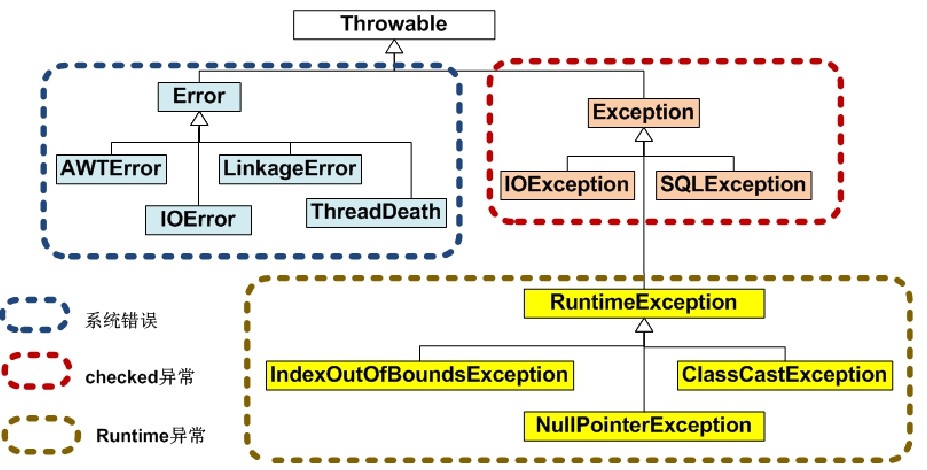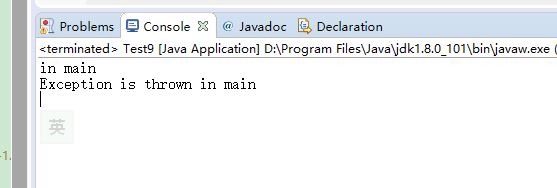动手动脑
(1) 请阅读并运行AboutException.java示例,
源代码:
1 import javax.swing.*; 2 3 class AboutException { 4 public static void main(String[] a) 5 { 6 int i=1, j=0, k; 7 k=i/j; 8 9 10 try 11 { 12 13 k = i/j; // Causes division-by-zero exception 14 //throw new Exception("Hello.Exception!"); 15 } 16 17 catch ( ArithmeticException e) 18 { 19 System.out.println("被0除. "+ e.getMessage()); 20 } 21 22 catch (Exception e) 23 { 24 if (e instanceof ArithmeticException) 25 System.out.println("被0除"); 26 else 27 { 28 System.out.println(e.getMessage()); 29 30 } 31 } 32 33 34 finally 35 { 36 JOptionPane.showConfirmDialog(null,"OK"); 37 } 38 39 } 40 }
答:Java中的异常捕获语句
Try{
//可能发生运行错误的代码;
}
catch(异常类型 异常对象引用){
//用于处理异常的代码
}
finally{
//用于“善后” 的代码
}
Java 中所有可捕获的异常都派生自 Exception 类。
把可能会发生错误的代码放进try语句块中。
当程序检测到出现了一个错误时会抛出一个异常对象。异常处理代码会捕获并处理这个错误。
catch语句块中的代码用于处理错误。
当异常发生时,程序控制流程由try语句块跳转到catch语句块。
不管是否有异常发生,finally语句块中的语句始终保证被执行。
如果没有提供合适的异常处理代码,JVM将会结束掉整个应用程序。

Throwable类有两个直接子类:
Exception:出现的问题是可以被捕获的;
Error:系统错误,通常由JVM处理。
可捕获的异常又可以分为两类:
(1)Check异常:直接派生自Exception的异常类,必须被捕获或再次声明抛出
(2)Runtime异常:派生自RuntimeException的异常类。使用throw语句可以随时抛出这种异常对象:
throw new ArithmeticException(…);
(2)多层的异常捕获-1
阅读以下代码(CatchWho.java),写出程序运行结果:
程序源代码:
1 public class CatchWho { 2 public static void main(String[] args) { 3 try { 4 try { 5 throw new ArrayIndexOutOfBoundsException(); 6 } 7 catch(ArrayIndexOutOfBoundsException e) { 8 System.out.println( "ArrayIndexOutOfBoundsException" + "/内层try-catch"); 9 } 10 11 throw new ArithmeticException(); 12 } 13 catch(ArithmeticException e) { 14 System.out.println("发生ArithmeticException"); 15 } 16 catch(ArrayIndexOutOfBoundsException e) { 17 System.out.println( "ArrayIndexOutOfBoundsException" + "/外层try-catch"); 18 } 19 } 20 }
答:

多层的异常捕获-2
写出CatchWho2.java程序运行的结果
程序源代码:
1 public class CatchWho2 { 2 public static void main(String[] args) { 3 try { 4 try { 5 throw new ArrayIndexOutOfBoundsException(); 6 } 7 catch(ArithmeticException e) { 8 System.out.println( "ArrayIndexOutOfBoundsException" + "/内层try-catch"); 9 } 10 throw new ArithmeticException(); 11 } 12 catch(ArithmeticException e) { 13 System.out.println("发生ArithmeticException"); 14 } 15 catch(ArrayIndexOutOfBoundsException e) { 16 System.out.println( "ArrayIndexOutOfBoundsException" + "/外层try-catch"); 17 } 18 } 19 }
答:

(3)当有多个嵌套的try…catch…finally时,要特别注意finally的执行时机。
请先阅读 EmbedFinally.java示例,再运行它,观察其输出并进行总结。
程序源代码:
1 public class EmbededFinally { 2 3 4 public static void main(String args[]) { 5 6 int result; 7 8 try { 9 10 System.out.println("in Level 1"); 11 12 13 try { 14 15 System.out.println("in Level 2"); 16 // result=100/0; //Level 2 17 18 try { 19 20 System.out.println("in Level 3"); 21 22 result=100/0; //Level 3 23 24 } 25 26 catch (Exception e) { 27 28 System.out.println("Level 3:" + e.getClass().toString()); 29 30 } 31 32 33 finally { 34 35 System.out.println("In Level 3 finally"); 36 37 } 38 39 40 // result=100/0; //Level 2 41 42 43 } 44 45 catch (Exception e) { 46 47 System.out.println("Level 2:" + e.getClass().toString()); 48 49 } 50 finally { 51 52 System.out.println("In Level 2 finally"); 53 54 } 55 56 // result = 100 / 0; //level 1 57 58 } 59 60 catch (Exception e) { 61 62 System.out.println("Level 1:" + e.getClass().toString()); 63 64 } 65 66 finally { 67 68 System.out.println("In Level 1 finally"); 69 70 } 71 72 } 73 74 }
答:

特别注意:
当有多层嵌套的finally时,异常在不同的层次抛出 ,在不同的位置抛出,可能会导致不同的finally语句块执行顺序。
辨析:finally语句块一定会执行吗?
请通过 SystemExitAndFinally.java示例程序回答上述问题
程序源代码:
1 public class SystemExitAndFinally { 2 3 4 public static void main(String[] args) 5 { 6 7 try{ 8 9 10 System.out.println("in main"); 11 12 throw new Exception("Exception is thrown in main"); 13 14 //System.exit(0); 15 16 17 } 18 19 catch(Exception e) 20 21 { 22 23 System.out.println(e.getMessage()); 24 25 System.exit(0); 26 27 } 28 29 finally 30 31 { 32 33 System.out.println("in finally"); 34 35 } 36 37 } 38 39 40 }
答:不一定执行finally语句的内容,抛出的错误决定执行的catch语句再执行finally语句。

课后作业2动手动脑
编写一个程序,此程序在运行时要求用户输入一个 整数,代表某门课的考试成绩,程序接着给出“不及格”、“及格”、“中”、“良”、“优”的结论。
要求程序必须具备足够的健壮性,不管用户输入什 么样的内容,都不会崩溃。
程序源代码:
1 import java.util.*; 2 public class Test9 { 3 4 5 public static void main(String[] args)throws Exception 6 { 7 Scanner cin=new Scanner(System.in); 8 System.out.println("请输入考试成绩"); 9 try{ 10 String in=cin.next(); 11 boolean flag=true; 12 for(int i=0;i<in.length()&&flag;i++){ 13 if(in.charAt(i)<=48||in.charAt(i)>=57) 14 flag=false; 15 } 16 if(flag) 17 throw new Exception("包含非法字符"); 18 double m=Double.parseDouble(in); 19 if(m>=90) 20 System.out.println("优"); 21 else if(m>=80) 22 System.out.println("良"); 23 else if(m>=70) 24 System.out.println("中"); 25 else if(m>=60) 26 System.out.println("及格"); 27 else 28 System.out.println("不及格"); 29 } 30 catch(Exception a){ 31 System.out.println(a.getMessage()); 32 System.exit(0); 33 } 34 35 } 36 37 38 }
程序截图验证:

